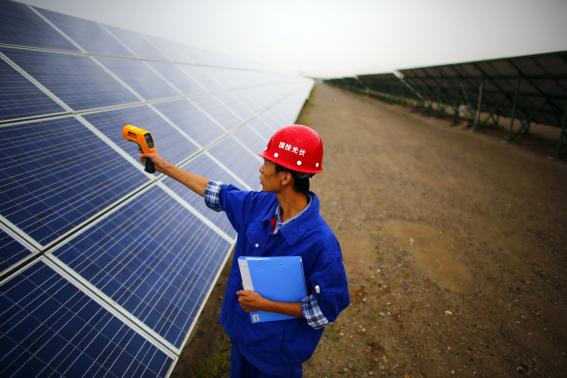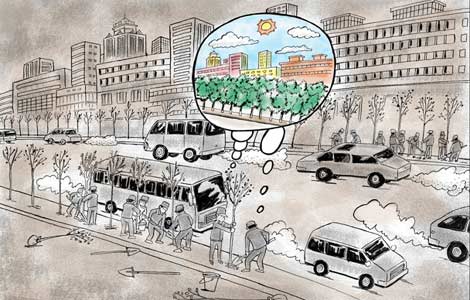China's solar industry rebounds
Updated: 2014-01-24 11:34
(Agencies)
|
||||||||
|
 |
|
A worker inspects solar panels at a solar farm in Dunhuang, 950km (590 miles) northwest of Lanzhou, Gansu province Sept 16, 2013. [Photo/Reuters] |
China's solar panel industry is showing signs of booming again after a prolonged downturn - raising fears of another bust when the splurge of public money that is driving a spike in demand dries up.
Lured by generous power tariffs and financing support to promote renewable energy, Chinese firms are racing to develop multi-billion dollar solar generating projects in the Gobi desert and barren hills of China's vast north and northwest.
The sweeteners have not only lured traditional energy investors like China Power Investment Corp, but also a host of solar panel makers and even companies such as toll road operator Huabei Express and Jiangsu Kuangda Auto Textile Group.
Some solar panel manufacturers, encouraged by a recovery in sales in the last two quarters - largely on surging demand from China and Japan - are expanding production capacity, even though the overall sector remains mired in a severe glut.
But industry officials worry fast-growing generation capacity will increase fiscal pressures on China and Japan and force them to cut subsidies which will then hit demand, just as happened with previous big solar users Germany, Spain and Italy.
"The key is whether the Chinese government is determined enough to boost solar generation," Sun Haiyan, senior executive at Trina Solar, said when asked if the current solar expansion in China was sustainable.
China already boasts solar manufacturing capacity of about 45 gigawatts (GW), enough to meet global demand this year.
Trina Solar, JinkoSolar, Yingli Green Energy and Canadian Solar - among the world's largest solar manufacturers that also include Japan's Sharp Corp and US SunPower Corp - are adding 3 GW of capacity, according to industry specialists and Chinese media.
Beijing is trying to consolidate the sector and force out the legion of small "zombie plants" currently sitting idle, but analysts say it faces stiff resistance from indebted regional and city governments that have backed local solar champions.
Michael Barker, analyst at global solar research firm Solarbuzz, said a risk now faced by the solar panel industry was manufacturers may react to improved demand "with somewhat irrational exuberance".
"This could upset the stabilization process that has occurred during the past year, once again creating an overcapacity situation," he wrote in a note this week.
Subsidy burden
Beijing's decision in July to more than quadruple solar generating capacity to 35 GW by 2015, and Japan's push to find alternatives to lost nuclear power following the 2011 Fukushima disaster, have revitalized the moribund Chinese panel industry.
China installed 8 GWs last year, turning it into the world's largest solar market. That included 6 GW of solar farms - utility-scale, ground-mounted facilities - and 2 GWs of distributed solar energy such as rooftop installations. This year, it is talking about adding 14 GWs.
Installing 35 GW of solar capacity would cost around $50 billion, plus subsidies granted to solar power producers under long-term purchase agreements.
But it's uncertain how long the current strong Chinese and Japanese demand, expected to account for 40-45 percent of global installations forecast for this year, will last.
With 100 million people still living in poverty, Beijing is unlikely to keep doling out generous solar subsidies indefinitely. Previous investment in solar plants in China has been hurt by delays in subsidy payments.
Japan has already lowered solar power tariff once in 2013.
Globally, the solar industry has made significant gains in driving down costs over the last few years, but it has yet to be weaned off big subsidies. Critics say the world should hold back from large-scale solar expansion until costs come down further and conversion efficiency of solar panels improves.
Solar rush
So far solar power only accounts for a small proportion of total installed power capacity in China, the world's largest energy user, which is predominantly fired by coal.
But whilst the potential would seem to be large, a rapid build-up of solar and wind farms in western China has already created a problem.
State Grid Corp of China has been struggling to transmit power from there to population hubs in the south and east due to a lack of a comprehensive high-voltage and smart grid to harness the intermittent renewable power.
Lin Boqiang, director of the China Centre of Energy Economics at Xiamen University and an adviser to China's National Energy Administration, said he has long-term faith in China's solar power development but reckons grid access is a "tremendous challenge".
Yet generous power tariffs and sweet loans granted by China for solar development have triggered what some analysts call "solar rush" for mostly solar farms in remote western China, where sunshine is abundant.
Beijing is buying electricity from solar farm investors at up to 1.0 yuan/kilowatt hour for up to 20 years, attractive terms that offer a relatively predictable annual return of more than 10 percent.
Separately, US trade officials on Thursday opened investigations into imports of certain solar power products from China and Taiwan, a move that could have a major impact on the nation's fast-growing solar market.
In the last few weeks, Chinese solar panel makers have made a slew of announcements to develop solar farms. They expect it to become a key part of their business as it would form a stable source of demand for their products.
Trina said on December 30 that it had signed a deal to develop a mega 1-GW solar farm project in the western province of Xinjiang. It also announced a plan to build a panel factory there for the project.
Shunfeng Photovoltaic, which is buying the main unit of bankrupt former top solar panel maker Suntech Power Holdings, this month vowed to invest 80 billion yuan ($13 billion) to develop 10-GW projects - nearly 30 percent of Germany's solar installed capacity - over the next three years.
"We want to develop 3 GWs a year so we need more panel capacity," said Shunfeng chairman Zhang Yi. ($1 = 6.0502 Chinese yuan)

 Reforms aim to put soccer back on track
Reforms aim to put soccer back on track
 'Small New Year' celebrations across China
'Small New Year' celebrations across China
 New views: amazing 3D pencil drawings
New views: amazing 3D pencil drawings
 US anti-abortion rallies march for life
US anti-abortion rallies march for life
 PLA navy drills in South China Sea
PLA navy drills in South China Sea
 Catnaps help travelers keep going
Catnaps help travelers keep going
 Japan seeks US understanding about dolphin hunt
Japan seeks US understanding about dolphin hunt
 Snow storm hits US East Coast
Snow storm hits US East Coast
Most Viewed
Editor's Picks

|

|

|

|

|

|
Today's Top News
Li seeks 'good beginning' to economy in 2014
CPC rolls out 'mass line' rules
China reports 6 new human H7N9 cases
China seeks to attract skilled foreign workers
NSA phone program illegal
Abe told to face up to wartime past
Cities halt live poultry trading
State Council mulls work report
US Weekly

|

|





